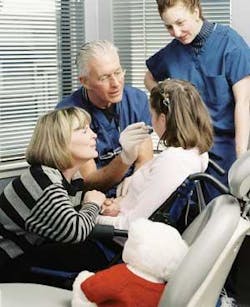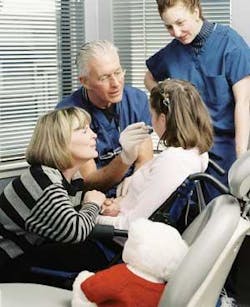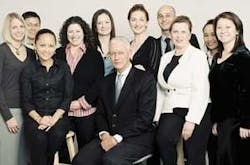Making the extraordinary ordinary
Story special to DE&M. Cover and story photos by Ross Pelton, Ross Pelton Photography (www.rosspelton.com)
For one San Francisco dental practice, extraordinary patient accommodations have become ordinary. Focusing almost exclusively on special care dentistry, the Blende Dental Group routinely treats patients from across the country and the globe whose conditions require case-specific accommodations and critical care.
The need for special needs dentistry is great, according to 2003 U.S. Census data. More than 34 million adults and 5 million children in this country - a staggering 12 percent of the U.S. population - are mentally or physically disabled. Add to this another 15 percent of U.S. citizens who are profoundly afraid of dentistry and avoid care, and it’s clear that one-fourth of all Americans could benefit from a special care dental practice.
For more than 20 years, Dr. David Blende has focused his practice on patients with a range of medical conditions and issues, from autism to Alzheimer’s dementia, from Parkinson’s to dental phobia. Most of their patients are referred by general dentists - to whom the patients return for long-term management after completion of their procedures at the Blende Dental Group. The team regularly performs extensive and complicated dental work for traveling patients who can make only one trip to San Francisco for treatment.
The group also offers the full continuum of sedation options - from general anesthesia in a hospital operating room, and in-office intravenous (I.V.) sedation administered and monitored by a physician anesthesiologist, in addition to oral conscious sedation. In fact, the Blende Dental Group leads the nation in the completion of full-mouth rehabilitation cases under general anesthesia.
“Dental patients can now benefit from the same safe anesthesia options that physicians in hospitals have offered their patients for decades,” says Dr. Blende who, together with his staff, offers a CE course - “Utilizing Sedation Modalities to Increase Case Acceptance for Your Existing Patient Population.”
To work on complex cases in a surgical setting, dentists and specialists need to work quickly to achieve a predictable result. Dr. Blende began his career treating poor and malnourished children in inner city Los Angeles - patients who often had as many as 20 cavities.
“Because pediatric anesthesiology was limited at that time, and children are higher-risk patients,” he explains, “the rule in the office was you could only use general anesthesia on a patient for an hour.” That’s when Dr. Blende discovered he had a knack for the speed and precision required in special cases.
His staff’s attention to detail has also enabled the practice to flourish. Mandy Robbins, a patient referred from New Mexico by Dr. Ray Lyons, the past president of Special Needs Dentistry, offers an illustrative example of how the practice employs teamwork, careful management of logistics, and an exhaustive review of each case and its appropriate accommodations. Treated by the Blende Dental Group in 2004, Robbins is a 21-year-old woman with profound autism and seizure disorder. Her teeth were ravaged by Amelogenesis Imperfecta (AI) and chronic parafunctional bruxism.
Like other out-of-town patients, Robbins’ treatment was largely planned in advance of her trip to San Francisco. Working in partnership with her referring dentist, Dr. Lyons, Dr. Blende discussed her condition and care. Practice manager Amanda White, a registered nurse, learned more from Robbins’ mother about the patient’s autism, her personality, medications, and other medical conditions, insurance, financial concerns, and travel needs. A Patient Care Coordinator gathered Robbins’ medical and dental records, assisted her family and physician with the pre-operative work-ups, provided her family with a proposed treatment plan, estimated fees and completed financial arrangements, and helped with travel arrangements. One full-time employee focuses exclusively on hospital arrangements. As challenging as it can be to manage the numerous logistics of their cases, the team is buoyed by their results, restoring smiles, and relieving pain among patients that might otherwise suffer needlessly.
Arriving in San Francisco on a Wednesday, Robbins had an exam and consultation with Dr. Blende. Thursday morning, she was admitted to the hospital, prepped, and taken to the operating room where she was met by Dr. Blende and his team, who bring their equipment and tools with them for each hospital case. In an eight-and-a-half-hour surgery in which six-handed dentistry was employed, Robbins had 27 crown preparations and impressions by Dr. Blende; extractions of teeth #1, #16, #17, #32, and palatally impacted #13 by oral surgeon Dr. Michael Barkin; root canal therapy on #6, #7, and #11 by endodontist Dr. Ralan Wong, and four quadrants of gingivoplasty, curettage, and root-planing by periodontist Dr. Brand Ahn.
While Robbins and her family enjoyed sightseeing over the weekend, Dr. Blende’s dental laboratory was hard at work creating the patient’s restorations. She returned to the operating room Monday for four hours to receive 27 final porcelain-fused-to-metal crowns. After a postoperative check-up the next morning, Robbins returned home, smiling broadly for the first time in many years. With her case completed, follow-up care with Dr. Lyons was arranged.
Last year, patients traveled from 13 countries and 21 states to take advantage of the Blende Dental Group’s well honed techniques and teamwork. Though his staff already speaks 11 languages, to ensure patient satisfaction, each member of Dr. Blende’s staff must speak the most important language of all - that of compassion for the population they serve.
“One of our rules is not to let the patient’s overlying medical condition dictate the treatment plan,” Dr. Blende states. “We see the person first, and design the elegance of the treatment to match that individual. Then we look at the disability and set about the task of defeating its limitations.
“I encourage others to experience the personal satisfaction of treating people whose special needs require special care. But also know your limits, know the risks, and know where to turn for more information.”
To learn more, Dr. Blende recommends the following resources: Special Care Dentistry at www.scdonline.com; The American Association of Hospital Dentists, The Academy of Dentistry for Persons with Disabilities, and the American Society for Geriatric Dentistry.
Dr. David Blende is Chief of the Dental Division at California Medical Center hospital in San Francisco. A graduate of University of Southern California Dental School, Dr. Blende has practiced special needs dentistry for 20 years. He is a member of the American Association of Hospital Dentists, and the former Chairman of the California Dental Association’s Council on Scientific Affairs and Research. For more information, call Dr. Blende at (800) 575-3375 or visit www.drblende.com.


